Hyundai Accent 2010 User Guide
Manufacturer: HYUNDAI, Model Year: 2010, Model line: Accent, Model: Hyundai Accent 2010Pages: 284, PDF Size: 10.23 MB
Page 11 of 284
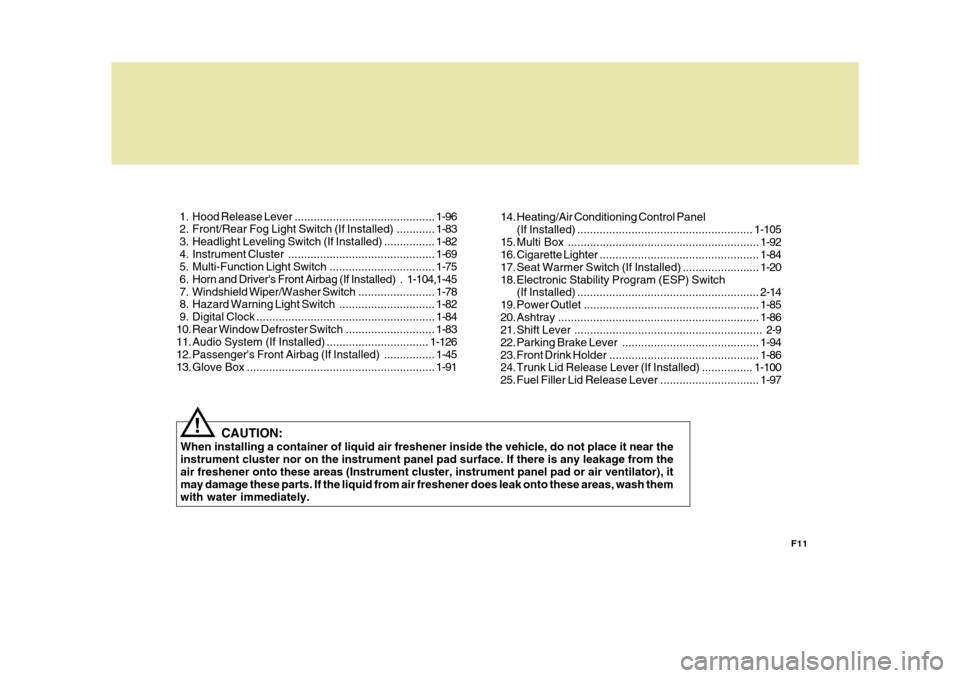
F11
CAUTION:
When installing a container of liquid air freshener inside the vehicle, do not place it near the instrument cluster nor on the instrument panel pad surface. If there is any leakage from the air freshener onto these areas (Instrument cluster, instrument panel pad or air ventilator), it may damage these parts. If the liquid from air freshener does leak onto these areas, wash themwith water immediately.
!
1. Hood
Release Lever ............................................ 1-96
2. Front/Rear Fog Light Switch (If Installed) ............ 1-83
3. Headlight Leveling Switch (If Installed) ................ 1-82
4. Instrument Cluster.............................................. 1-69
5. Multi-Function Light Switch................................. 1-75
6. Horn and Driver's Front Airbag (If Installed) . 1-104,1-45
7. Windshield W iper/Washer Switch ........................1-78
8. Hazard Warning Light Switch.............................. 1-82
9. Digital Clock ........................................................ 1-84
10. Rear Window De froster Switch ............................ 1-83
11. Audio System (If Installed) ................................ 1-126
12. Passenger's Front Airbag (If Installed) ................1-45
13. Glov e Box ........................................................... 1-9114. Heating/Air Conditioning Control Panel
(If Installed) ....................................................... 1-105
15. Multi Box ............................................................ 1-92
16. Cigarette Lighter .................................................. 1-84
17. Seat Warmer Switch (If Installed) ........................ 1-20
18. Electronic Stability Program (ESP) Switch (If Installed) ......................................................... 2-14
19. Power Outlet ....................................................... 1-85
20. Ashtray ............................................................... 1-86
21. Shift Lever ........................................................... 2-9
22. Parking Brake Lever ........................................... 1-94
23. Front Drink Holder ............................................... 1-86
24. Trunk Lid Release Lever (If Installed) ................1-100
25. Fuel Filler Lid Release Lever ...............................1-97
Page 12 of 284

YOUR VEHICLE AT A GLANCE
F12B255A03MC-GAT INDICATOR SYMBOLS ON THE INSTRUMENT PANEL * More detailed explanations of these items will be found begining on page 1-60.
Turn Signal Indicator Lights
SRS (Airbag) Service Reminder Indicator (If Installed) O/D OFF Indicator Light (Automatic transaxle only) High Beam Indicator Light
Low Oil Pressure Warning Light
ABS Service Reminder Indicator (If Installed)
Door Ajar Warning Light
Parking Brake/Low Brake Fluid Level Warning Light
Charging System Warning Light Fuel Filter Warning Light (Diesel only)
Low Fuel Level Warning Light Diesel Pre-heat Indicator Light (Diesel only)
Malfunction Indicator Light (If Installed)
Immobilizer Warning Light (If Installed)
Passenger's Front Airbag OFF Indicator Light (If Installed)
Trunk Lid/Tail Gate Open Warning Light
Engine Coolant Temperature Warning Light Seat Belt Warning Light
Electronic Power Steering (EPS) System Warning Light (If Installed)
Electronic Stability Program Indicator Lights (If Installed)
120
km/hOverspeed Warning Light (If Installed)
Automatic Transaxle Position Indicator Light (If Installed)
Page 13 of 284
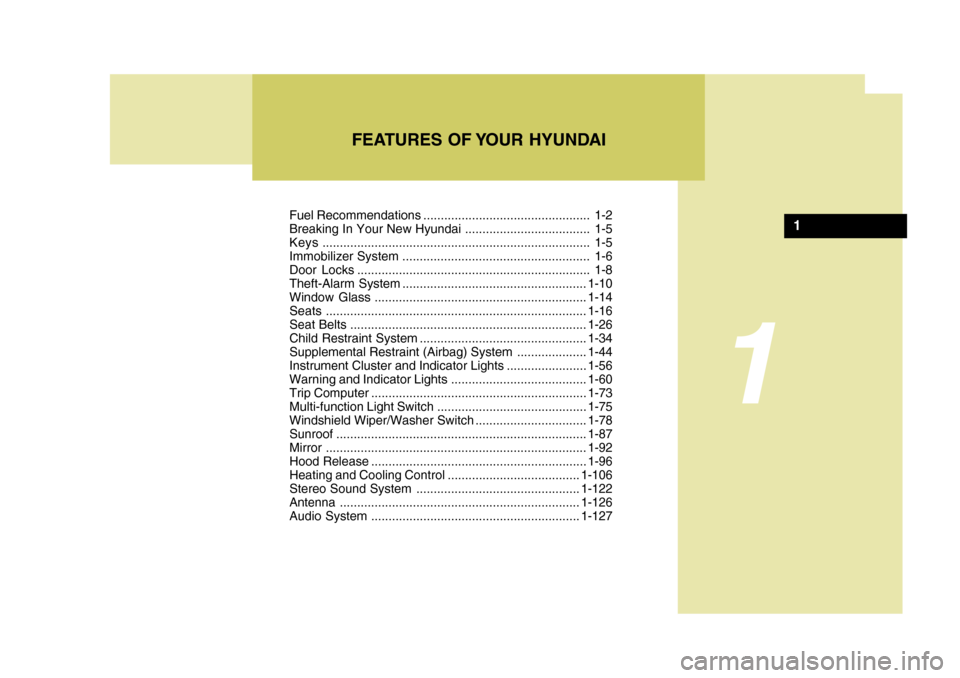
Fuel Recommendations ................................................ 1-2
Breaking In Your New Hyundai .................................... 1-5
Keys ............................................................................. 1-5
Immobilizer System ...................................................... 1-6
Door Locks ................................................................... 1-8Theft-Alarm S ystem ..................................................... 1-10
Window Glass ............................................................. 1-14
Seats ........................................................................... 1-16
Seat Belts .................................................................... 1-26
Child Restraint System ................................................ 1-34
Supplemental Restraint (Airbag) System.................... 1-44
Instrument Cluster and Indicator Lights .......................1-56
Warning and Indicator Lights....................................... 1-60
Trip Computer .............................................................. 1-73
Multi-function Light Switch ........................................... 1-75
Windshield Wiper/Washer Switch ................................1-78
Sunroof ........................................................................ 1-87
Mirror ........................................................................... 1-92
Hood R elease .............................................................. 1-96
Heating and Cooling Control ...................................... 1-106
Stereo Sound System ............................................... 1-122
Antenna ..................................................................... 1-126
Audio System ............................................................ 1-127
FEATURES OF YOUR HYUNDAI
1
1
Page 14 of 284
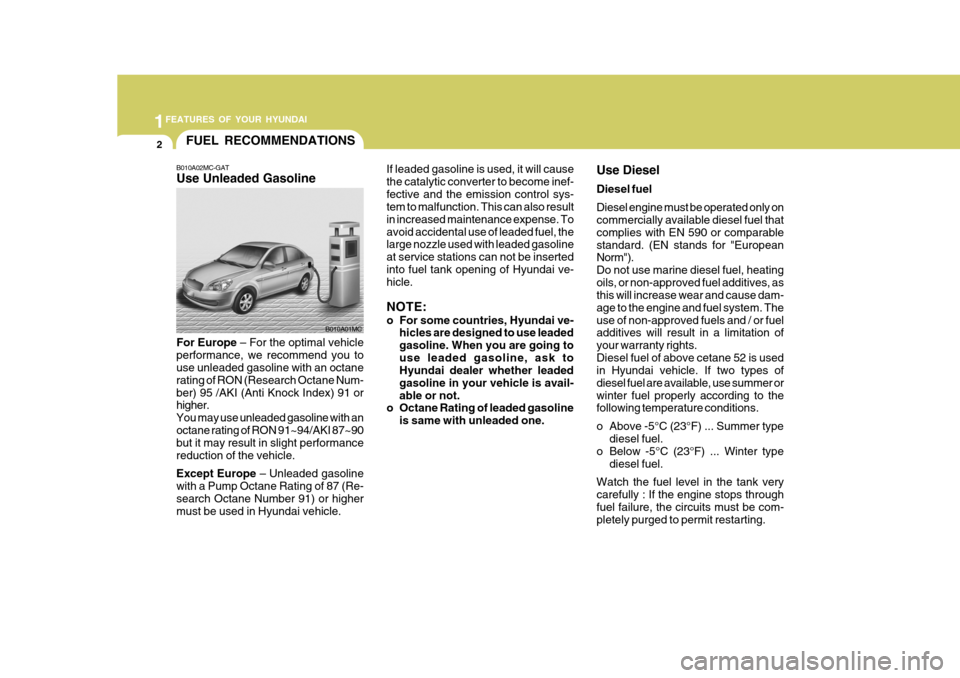
1FEATURES OF YOUR HYUNDAI
2FUEL RECOMMENDATIONS
B010A02MC-GAT Use Unleaded Gasoline If leaded gasoline is used, it will cause the catalytic converter to become inef-fective and the emission control sys- tem to malfunction. This can also result in increased maintenance expense. Toavoid accidental use of leaded fuel, the large nozzle used with leaded gasoline at service stations can not be insertedinto fuel tank opening of Hyundai ve- hicle. NOTE:
o For some countries, Hyundai ve-
hicles are designed to use leaded gasoline. When you are going touse leaded gasoline, ask to Hyundai dealer whether leaded gasoline in your vehicle is avail-able or not.
o Octane Rating of leaded gasoline
is same with unleaded one.
For Europe
– For the optimal vehicle
performance, we recommend you to use unleaded gasoline with an octane rating of RON (Research Octane Num-ber) 95 /AKI (Anti Knock Index) 91 or higher. You may use unleaded gasoline with anoctane rating of RON 91~94/AKI 87~90 but it may result in slight performance reduction of the vehicle. Except Europe – Unleaded gasoline
with a Pump Octane Rating of 87 (Re- search Octane Number 91) or higher must be used in Hyundai vehicle. B010A01MC
Use Diesel Diesel fuel Diesel engine must be operated only on commercially available diesel fuel that complies with EN 590 or comparablestandard. (EN stands for "European Norm"). Do not use marine diesel fuel, heatingoils, or non-approved fuel additives, as this will increase wear and cause dam- age to the engine and fuel system. Theuse of non-approved fuels and / or fuel additives will result in a limitation of your warranty rights.Diesel fuel of above cetane 52 is used in Hyundai vehicle. If two types of diesel fuel are available, use summer orwinter fuel properly according to the following temperature conditions.
o Above -5°C (23°F) ... Summer type
diesel fuel.
o Below -5°C (23°F) ... Winter type diesel fuel.
Watch the fuel level in the tank very carefully : If the engine stops through fuel failure, the circuits must be com- pletely purged to permit restarting.
Page 15 of 284
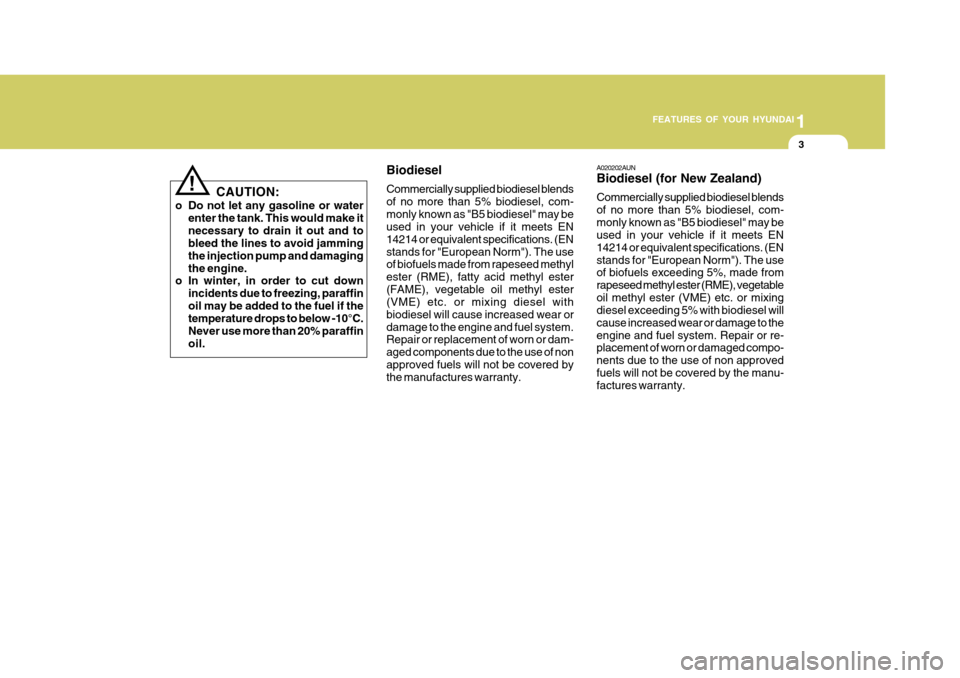
1
FEATURES OF YOUR HYUNDAI
3
CAUTION:
o Do not let any gasoline or water enter the tank. This would make it necessary to drain it out and to bleed the lines to avoid jamming the injection pump and damagingthe engine.
o In winter, in order to cut down
incidents due to freezing, paraffinoil may be added to the fuel if the temperature drops to below -10°C. Never use more than 20% paraffinoil.
! Biodiesel Commercially supplied biodiesel blends of no more than 5% biodiesel, com-monly known as "B5 biodiesel" may be used in your vehicle if it meets EN 14214 or equivalent specifications. (ENstands for "European Norm"). The use of biofuels made from rapeseed methyl ester (RME), fatty acid methyl ester(FAME), vegetable oil methyl ester (VME) etc. or mixing diesel with biodiesel will cause increased wear ordamage to the engine and fuel system. Repair or replacement of worn or dam- aged components due to the use of nonapproved fuels will not be covered by the manufactures warranty. A020202AUN Biodiesel (for New Zealand) Commercially supplied biodiesel blends of no more than 5% biodiesel, com-monly known as "B5 biodiesel" may be used in your vehicle if it meets EN 14214 or equivalent specifications. (ENstands for "European Norm"). The use of biofuels exceeding 5%, made from rapeseed methyl ester (RME), vegetableoil methyl ester (VME) etc. or mixing diesel exceeding 5% with biodiesel will cause increased wear or damage to theengine and fuel system. Repair or re- placement of worn or damaged compo- nents due to the use of non approvedfuels will not be covered by the manu- factures warranty.
Page 16 of 284
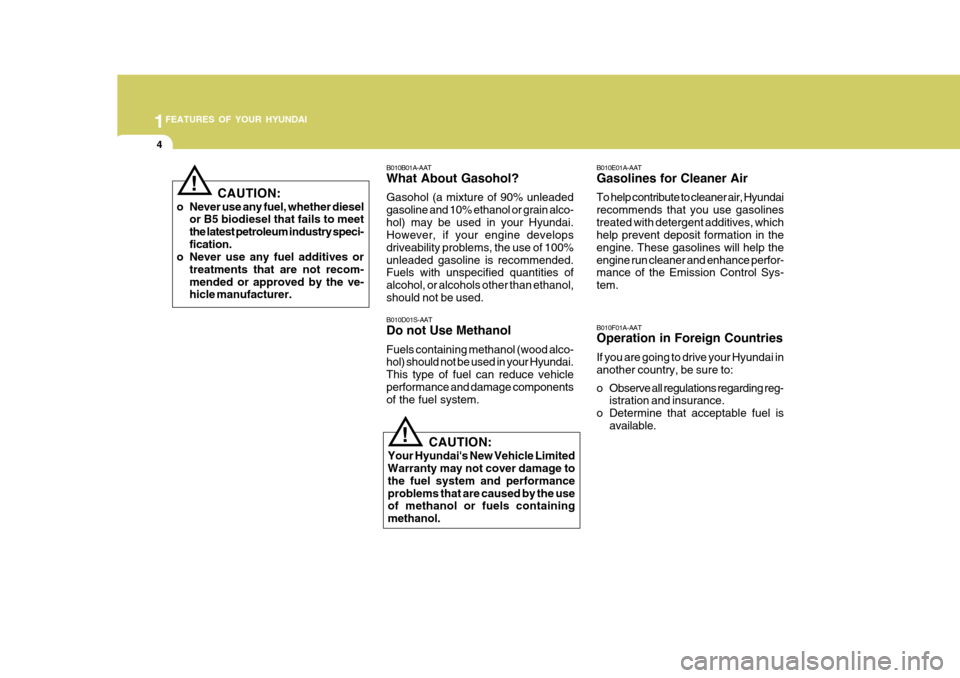
1FEATURES OF YOUR HYUNDAI
4
B010B01A-AAT What About Gasohol? Gasohol (a mixture of 90% unleaded gasoline and 10% ethanol or grain alco-hol) may be used in your Hyundai. However, if your engine develops driveability problems, the use of 100%unleaded gasoline is recommended. Fuels with unspecified quantities of alcohol, or alcohols other than ethanol,should not be used. B010D01S-AAT Do not Use Methanol Fuels containing methanol (wood alco- hol) should not be used in your Hyundai. This type of fuel can reduce vehicleperformance and damage components of the fuel system.
CAUTION:
Your Hyundai's New Vehicle LimitedWarranty may not cover damage to the fuel system and performanceproblems that are caused by the use of methanol or fuels containing methanol.
! B010E01A-AAT Gasolines for Cleaner Air To help contribute to cleaner air, Hyundai recommends that you use gasolinestreated with detergent additives, which help prevent deposit formation in the engine. These gasolines will help theengine run cleaner and enhance perfor- mance of the Emission Control Sys- tem. B010F01A-AAT Operation in Foreign Countries If you are going to drive your Hyundai in another country, be sure to:
o Observe all regulations regarding reg-
istration and insurance.
o Determine that acceptable fuel is available.
! CAUTION:
o Never use any fuel, whether diesel or B5 biodiesel that fails to meet the latest petroleum industry speci-fication.
o Never use any fuel additives or
treatments that are not recom-mended or approved by the ve- hicle manufacturer.
Page 17 of 284
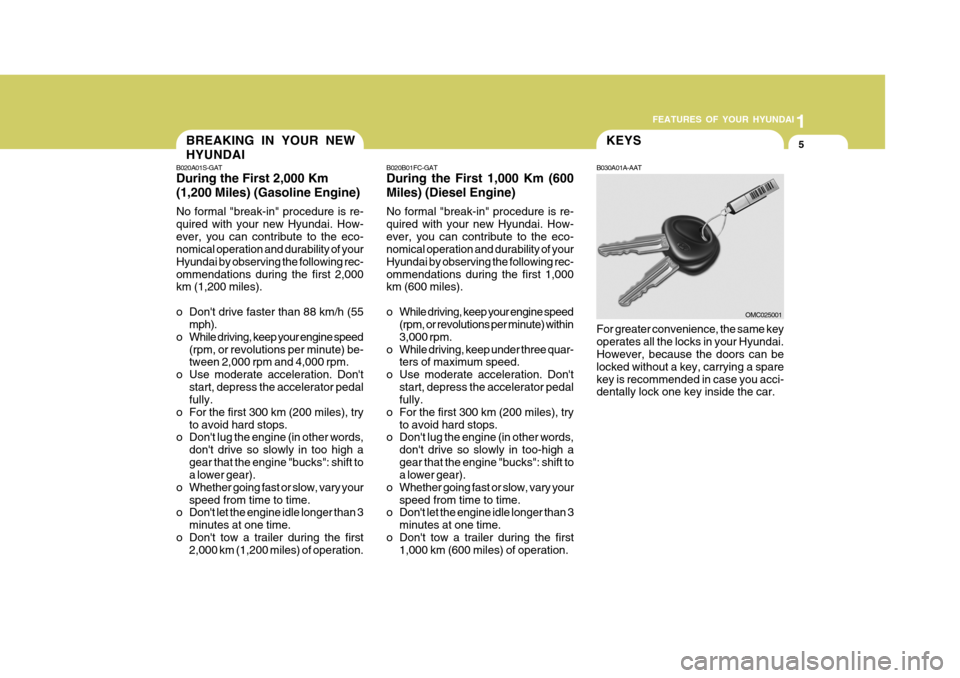
1
FEATURES OF YOUR HYUNDAI
5KEYS
B020B01FC-GAT During the First 1,000 Km (600 Miles) (Diesel Engine) No formal "break-in" procedure is re- quired with your new Hyundai. How-ever, you can contribute to the eco- nomical operation and durability of your Hyundai by observing the following rec-ommendations during the first 1,000 km (600 miles).
o While driving, keep your engine speed (rpm, or revolutions per minute) within 3,000 rpm.
o While driving, keep under three quar- ters of maximum speed.
o Use moderate acceleration. Don't start, depress the accelerator pedal fully.
o For the first 300 km (200 miles), try to avoid hard stops.
o Don't lug the engine (in other words,
don't drive so slowly in too-high a gear that the engine "bucks": shift to a lower gear).
o Whether going fast or slow, vary your
speed from time to time.
o Don't let the engine idle longer than 3
minutes at one time.
o Don't tow a trailer during the first 1,000 km (600 miles) of operation. B030A01A-AAT For greater convenience, the same key operates all the locks in your Hyundai. However, because the doors can be locked without a key, carrying a sparekey is recommended in case you acci- dentally lock one key inside the car.
OMC025001
BREAKING IN YOUR NEW HYUNDAI
B020A01S-GAT During the First 2,000 Km (1,200 Miles) (Gasoline Engine) No formal "break-in" procedure is re- quired with your new Hyundai. How-ever, you can contribute to the eco- nomical operation and durability of your Hyundai by observing the following rec-ommendations during the first 2,000 km (1,200 miles).
o Don't drive faster than 88 km/h (55
mph).
o While driving, keep your engine speed (rpm, or revolutions per minute) be- tween 2,000 rpm and 4,000 rpm.
o Use moderate acceleration. Don't start, depress the accelerator pedalfully.
o For the first 300 km (200 miles), try to avoid hard stops.
o Don't lug the engine (in other words,
don't drive so slowly in too high a gear that the engine "bucks": shift to a lower gear).
o Whether going fast or slow, vary your
speed from time to time.
o Don't let the engine idle longer than 3
minutes at one time.
o Don't tow a trailer during the first 2,000 km (1,200 miles) of operation.
Page 18 of 284
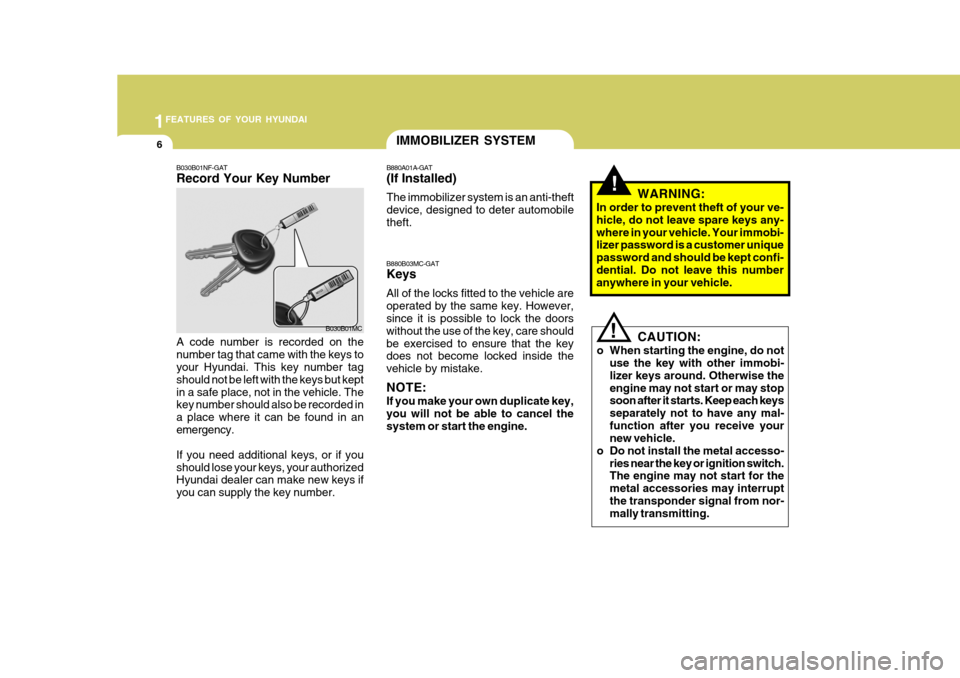
1FEATURES OF YOUR HYUNDAI
6IMMOBILIZER SYSTEM
B030B01NF-GAT Record Your Key Number A code number is recorded on the number tag that came with the keys to your Hyundai. This key number tag should not be left with the keys but keptin a safe place, not in the vehicle. The key number should also be recorded in a place where it can be found in anemergency. If you need additional keys, or if you should lose your keys, your authorized Hyundai dealer can make new keys if you can supply the key number. B880A01A-GAT (If Installed) The immobilizer system is an anti-theft device, designed to deter automobiletheft.
B880B03MC-GAT Keys All of the locks fitted to the vehicle are operated by the same key. However, since it is possible to lock the doors without the use of the key, care shouldbe exercised to ensure that the key does not become locked inside the vehicle by mistake. NOTE: If you make your own duplicate key, you will not be able to cancel thesystem or start the engine.
B030B01MC CAUTION:
o When starting the engine, do not use the key with other immobi- lizer keys around. Otherwise theengine may not start or may stop soon after it starts. Keep each keys separately not to have any mal-function after you receive your new vehicle.
o Do not install the metal accesso- ries near the key or ignition switch.The engine may not start for the metal accessories may interruptthe transponder signal from nor- mally transmitting.!
!WARNING:
In order to prevent theft of your ve- hicle, do not leave spare keys any-where in your vehicle. Your immobi- lizer password is a customer unique password and should be kept confi-dential. Do not leave this number anywhere in your vehicle.
Page 19 of 284
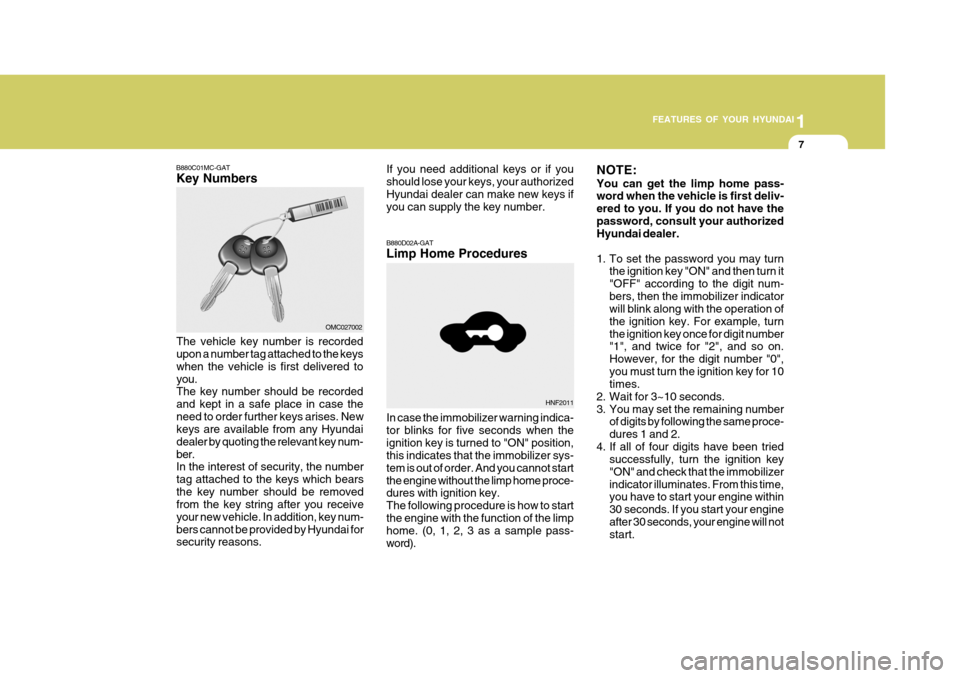
1
FEATURES OF YOUR HYUNDAI
7
NOTE: You can get the limp home pass- word when the vehicle is first deliv- ered to you. If you do not have thepassword, consult your authorized Hyundai dealer.
1. To set the password you may turn
the ignition key "ON" and then turn it "OFF" according to the digit num-bers, then the immobilizer indicator will blink along with the operation of the ignition key. For example, turnthe ignition key once for digit number "1", and twice for "2", and so on. However, for the digit number "0",you must turn the ignition key for 10 times.
2. Wait for 3~10 seconds.
3. You may set the remaining number of digits by following the same proce-dures 1 and 2.
4. If all of four digits have been tried successfully, turn the ignition key"ON" and check that the immobilizerindicator illuminates. From this time, you have to start your engine within 30 seconds. If you start your engineafter 30 seconds, your engine will not start.
B880D02A-GAT Limp Home Procedures In case the immobilizer warning indica- tor blinks for five seconds when theignition key is turned to "ON" position, this indicates that the immobilizer sys- tem is out of order. And you cannot startthe engine without the limp home proce- dures with ignition key. The following procedure is how to startthe engine with the function of the limp home. (0, 1, 2, 3 as a sample pass- word).
HNF2011
If you need additional keys or if youshould lose your keys, your authorizedHyundai dealer can make new keys if you can supply the key number.B880C01MC-GAT Key Numbers
The vehicle key number is recorded upon a number tag attached to the keys when the vehicle is first delivered toyou. The key number should be recorded and kept in a safe place in case theneed to order further keys arises. New keys are available from any Hyundai dealer by quoting the relevant key num-ber. In the interest of security, the number tag attached to the keys which bearsthe key number should be removed from the key string after you receive your new vehicle. In addition, key num-bers cannot be provided by Hyundai for security reasons. OMC027002
Page 20 of 284
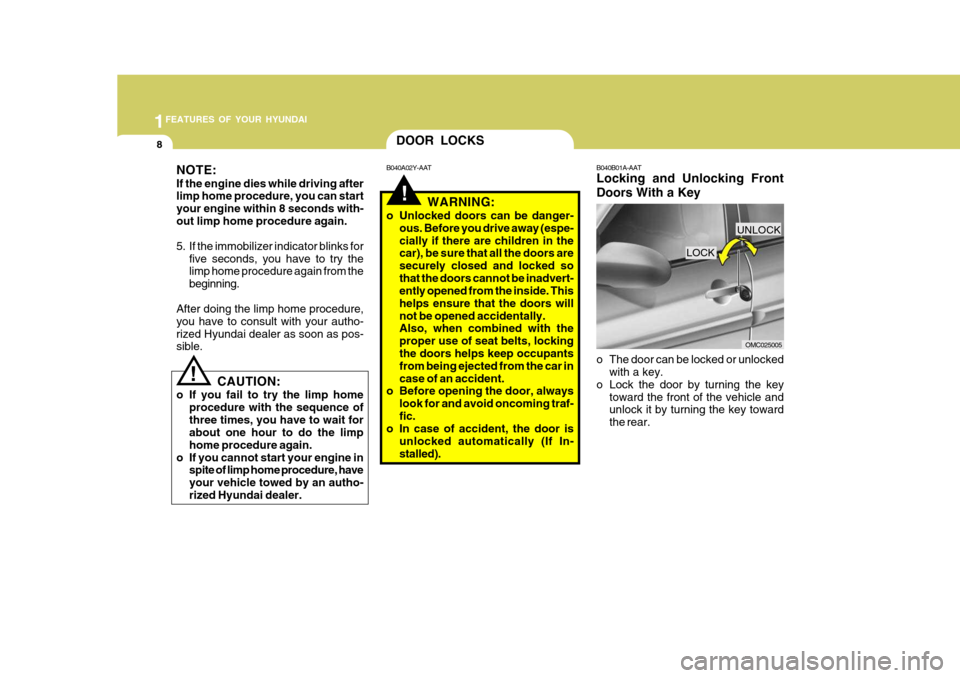
1FEATURES OF YOUR HYUNDAI
8
!
DOOR LOCKS
NOTE: If the engine dies while driving after limp home procedure, you can start your engine within 8 seconds with-out limp home procedure again.
5. If the immobilizer indicator blinks for five seconds, you have to try the limp home procedure again from the beginning.
After doing the limp home procedure,you have to consult with your autho-rized Hyundai dealer as soon as pos- sible.
! CAUTION:
o If you fail to try the limp home procedure with the sequence of three times, you have to wait for about one hour to do the limp home procedure again.
o If you cannot start your engine in spite of limp home procedure, haveyour vehicle towed by an autho-rized Hyundai dealer.
B040A02Y-AAT B040B01A-AAT
Locking and Unlocking Front Doors With a Key
WARNING:
o Unlocked doors can be danger- ous. Before you drive away (espe- cially if there are children in the car), be sure that all the doors are securely closed and locked sothat the doors cannot be inadvert- ently opened from the inside. This helps ensure that the doors willnot be opened accidentally. Also, when combined with the proper use of seat belts, locking the doors helps keep occupants from being ejected from the car incase of an accident.
o Before opening the door, always
look for and avoid oncoming traf-fic.
o In case of accident, the door is
unlocked automatically (If In-stalled). o The door can be locked or unlocked
with a key.
o Lock the door by turning the key
toward the front of the vehicle and unlock it by turning the key toward the rear.
LOCK
UNLOCK
OMC025005